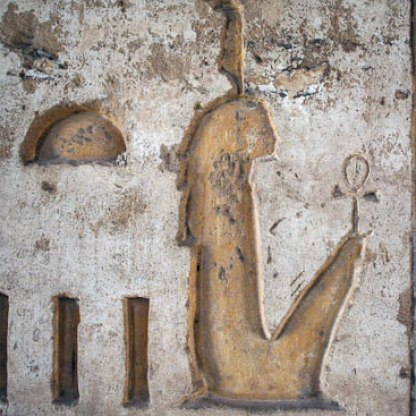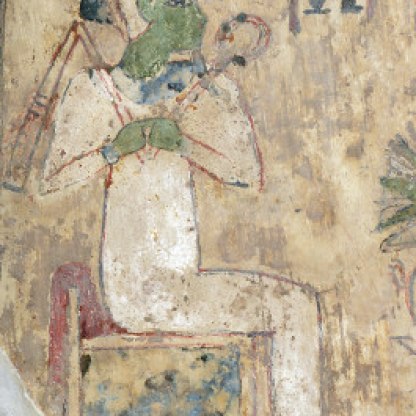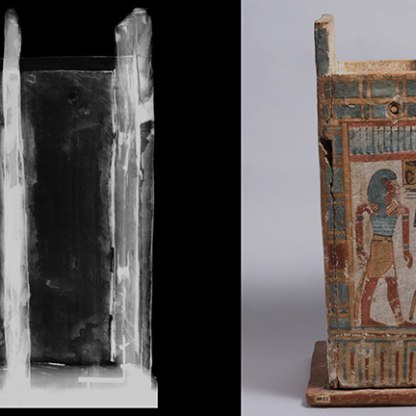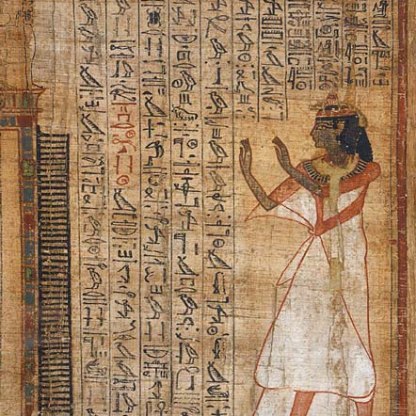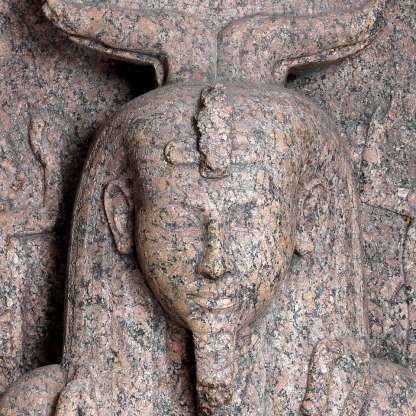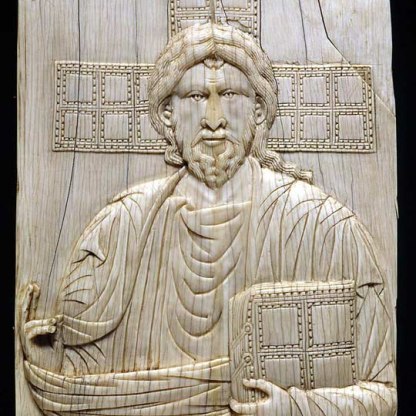
'The Osiris, beloved divine father, opener of the two doors of heaven of Ipetsut...'
This richly painted coffin, made from cartonnage – linen stiffened with plaster – once held the mummified remains of Nakhtefmut, an employee in Ipetsut, the temple of Amun-Re, the chief god at Thebes.
From the honorific titles quoted above, which are written in hieroglyphs down the front of the coffin, it seems that he held a significant position within this great sanctuary. The inscription states that the same titles were held by his father, grandfather and great-grandfather. Although the Egyptian king was considered the chief priest in the country, the everyday running of temples and the performance of rituals were delegated to other priests and functionaries. Judging by his coffin, Nakhtefmut was an important and wealthy man.
From top to toe, the intricate decoration tells of his hopes after death: that in return for a lifetime’s pious service, his spirit will be judged worthy of entering the afterlife. The pure gold face shows Nakhtefmut in the idealised, youthful form in which he expected to reach this blissful state. His narrow, plaited beard is that associated with Osiris, the god of the underworld. By the time Nakhtefmut was buried, it was believed that everyone who died became an Osiris.
In the middle of the coffin’s chest is the keynote of the decoration: an amulet of the goddess Maat, identifiable by her ostrich plume. Maat was the personification of world order, justice, truth and wisdom. It is her feather that was placed in the scales and weighed against the heart of the deceased during the judgment of the dead.
Other feathers dominate the decoration of the coffin. Indeed from a distance it seems that Nakhtefmut is almost entirely covered with them. Directly below the amulet of Maat, a ram-headed deity spreads his wings in a great curve, a solar disc on his head identifying him as Atum, a form of the sun god.
Another form of the sun god, this time with the head of a falcon, embraces the coffin’s waist, detail left. Further down, more wings, belonging to the goddesses Isis and Nephthys, cross over each other. These goddesses, protectors of Osiris and hence of the dead in general, are depicted twice – as winged creatures with female heads, and again with the heads of kites, an allusion to their role in the myth of Osiris. The body of Nakhtefmut is literally enveloped by the feathery, protective embrace of his deities.
Around the central section are two scenes involving other gods associated with judgement and the afterlife. On the left, as we look at the coffin, the ibis-headed god Thoth, the divine scribe, stands before a standard of Amun. He holds the pen and palette with which he writes down the verdict when the heart is weighed against the feather of Maat.
On the right, Horus, falcon-headed and wearing the dual crown of Upper and Lower Egypt, pours a libation onto an altar for his dead father Osiris, depicted in the form of a mummy. Behind Horus stand two of his four sons, guardians of the internal organs of the deceased after burial.
On the back of the coffin are words from the Negative Confession of the Egyptian Book of the Dead – a list recited by the deceased at the moment of his judgment. This was the final chance for the dead to deny any wrongdoing before the truth was revealed by the infallible feather of Maat.
Themes and periods
Data from our collections database
Coffin, of a priest in Karnak, Nakhtefmut. The mummy case is a moulded, hollow shell, with a slit up the back. After the mummy was inserted, the slit was laced together and a board inserted under the feet.
Acquisition and important dates
- Method of acquisition: Given
- Dates: 1896
